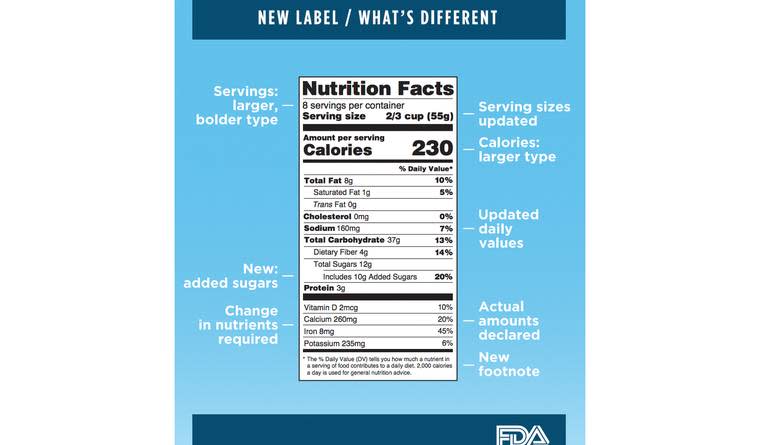Updated Nutrition Labels Will Show Added Sugars for First Time in History
Sugar, prepare for some serious scrutiny.
Today the U.S. Food and Drug Administration announced the long-awaited revamp of nutrition labels, which will finally display added sugar and percentages of daily values for sugar.
The labels have not changed significantly since 1994 (though in 2006, the FDA required labels to list trans fat), so this is a big deal. The design refresh will roll in July 2018, and here's what to expect.

Other than new bolding and font sizes, there are five main overhauls:
1. Serving sizes will be more accurate.
New labels will better reflect how much people eat, and the FDA will require some companies to change their portion sizes. For example, a standard serving of ice cream will now be listed as two-thirds of a cup instead of a half cup. Now that's more like it.
2. Labels will display grams of added sugars.
For years, nutritionists and some health officials have warned that the sugars added to products can fuel diabetes and obesity. Now consumers will have a better handle on how much sugar is really added to yogurts, sauces and other food items.
3. You can see the percent of the daily recommended intake for sugar and added sugar.
This data point has been notably absent from nutrition labels, but no more. Highlighting these numbers will help consumers put their sugar intake into perspective.
4. More vitamins are on the bottom of the label, and a few got taken off.
Since the FDA rules that Americans aren't getting enough vitamin D, calcium, iron and potassium, those nutrients will be required for new labels (calcium and iron are post on the current labels). Vitamins A and C wont' be required to go on the label because most Americans are getting sufficient amounts.
5. Labels will reflect modern percent of daily values.
These numbers will highlight the latest government recommendations in the 2015-2020 Dietary Guidelines for Americans. Recommendations have changed for sodium, fiber, and vitamin D.
All the hubbub over the new label might make a person wonder: Do consumers even read nutrition labels, anyway? Yes, more often than not, it turns out. Roughly 77% of American adults read labels when buying food, while less than 50% read them in 2002, the Wall Street Journal reported.
"I definitely think the changes in labels are a step in the right direction," Nora Minno, a registered dietitian and certified personal trainer, said in an email. She praised the label's inclusion of added sugar, noting that the country is finally waking up to how damaging excess sugar can be to our bodies. But, she said that the FDA needs to get tougher when it comes to vague food marketing terms like "natural" and "whole wheat."
Will the new labels actually help people eat healthier? Minno thinks so. "Knowledge is power," she said. The caveat, she noted, is educating people on how to use these tools to their advantage.


